The publication focuses on imagery from the near-50-year period in which abortion was legal in the United States. Here, she talks about abortions as an essential form of healthcare
Women answer phones; identical chairs are arranged around neutral rooms; hands press down gently onto someone’s back, or their foot. In Carmen Winant’s new photo book, The Last Safe Abortion, the images are humble, even banal – mostly made up of waiting rooms and women at work. Yet, interspersed between these scenes are images that have a greater charge: a balloon reading “abortion hotline”, a banner daubed with “abort the patriarchy,” a quilt wall-hanging, hand-stitched with “you are safe here”, or a woman gently spreading another woman’s legs.
The Last Safe Abortion is a spectacular work, precisely because of the unspectacular photographs it contains. Comprised of archival images taken between the 1960s and 90s, and Winant’s own photography, the book presents abortion as a vital form of care, and clinic staffers as vital, feminist care workers. More than that though, it shows abortion as routine – as profoundly normal – while also revealing beauty in this banality.
Winant has trod similar ground before, previously focusing on domestic violence workers, or, in her acclaimed 2018 work My Birth, presenting over 2,000 photographs of women in labour, including her own mother. At the same time, however, this project feels radically unique. On June 24, 2022, the US Supreme Court overturned the constitutional right to an abortion, reversing Roe v Wade. Winant had already begun work on this project, but the 2022 ruling brought it into devastatingly sharp relief. Now, The Last Safe Abortion feels like an invaluable record of an ongoing struggle – the daily work of resistance.
Below, in her own words, Carmen Winant tells the story behind The Last Safe Abortion.
“I started the project over four years ago. That was before the context in which I’m now situated – rapidly eroding abortion rights, reproductive justice and healthcare. I live in Ohio where none of this is abstract. It was one of the first states to enact a so-called ‘heartbeat bill’. I’ve never worked on a project that existed so ruthlessly in the present. Clinics were shuttering around me in real time – between emails as I worked. It made the project feel very real, and terrifying.

“There were two entry points into it. One is my own feminist politics. Reproductive healthcare, and justice work have always been the bedrock of how I relate to my own feminism. And then the other entry point is the strategy of anti-abortion activists, who have weaponised photography. I remember encountering those big, gory photographs of so-called ‘fetuses’. I teach photography. I think in photographs, and it felt to me like there was a chasm between how they were relating to and utilising photographs and how we were using slogans. Where was photographic representation in our movement? How could I think about it strategically as a tool? I just started to think, what is the visuality of abortion care?”
“Abortion clinics are feminist healthcare spaces, and I think that’s important to name and make distinct from a conventional healthcare context. They’re generally non-hierarchical, non-punitive and they treat the whole person, not just the body. My hope is that that feeling is conveyed in the photographs.
“If you Google ‘abortion’ or ‘abortion clinic’, it’s so often protests, counter-protests, a clinic that’s been firebombed, protesters screaming at incoming patients. It’s so loaded and so aggressive, and violent and hostile – it’s an agitated space. That’s not what it looks or feels like on the inside – all the mundane tasks, all the instrumental care embedded inside of that.

“One thing I was interested in was how the clinic gets the word out about themselves. How do they share information about their services? So there’s a lot of tabling at local community events. Bulletin boards, that kind of thing. There’s pictures of women sterilising medical equipment, but there’s also pictures from so and so's birthday party and so and so finishing off the roll, shooting pictures of themselves in the mirror. One thing that I encountered in various archives over and over – there’s so many staff birthday parties. I could have made a whole book of cakes! And so much tenderness. Touching, and support between each other or that they offer to patients. That to me is really reflective of their status in this community that is informed by feminist principles.
“99 per cent of the photographs are of staffers who are enacting the role of patient, because they’re not photographing their patients. unless, in a few cases, they have express permission. But there’s something that’s very tender about that. The staffers are standing in, they’re taking the time and they’re posing. They’re really deeply doing this work on all levels, and approaching photography as a tool, all these years before. So, when I asked myself, what is the visuality of abortion care, and where has it been as a tool in the movement? There it is. They’ve been doing it.”
The Last Safe Abortion by Carmen Winant is published by Mack and SPBH Editions, and is out now.






